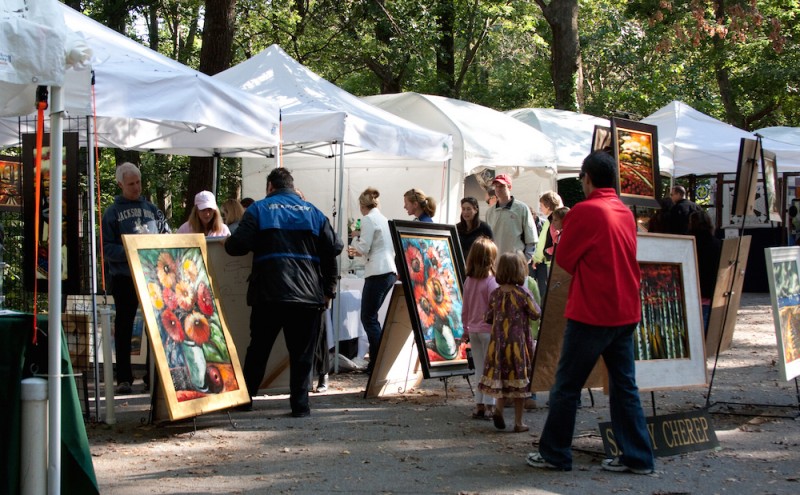Visual Artists: Why, and how, you should be using audio to grow your fanbase and sell more art

Visual artists too often struggle to effectively tell their story, connect with their audience and attract buyers. Especially in this era of the mobile citizen who has a deteriorating attention span and too many competing demands on their time. And though the visual artist who insists on making art that ‘stands for itself’ seems noble in pursuit, (I’m NOT against this!), my experience tells me that too often, their art is just left standing…underappreciated or misunderstood, forgotten or ignored altogether. This is tragic, and audio can help.
Audio, especially in the form of a trusted human voice, or even an atmospheric collection of contextual sounds, a musical arrangement, or some other creative aural expression, is a frequently overlooked and underestimated layer of the art-viewing experience that can create a strong emotional bond between you, your art and a potential patron. Let me share 3 reasons why I think you should try using audio as a companion to your visual art:
1. You can differentiate yourself with a multi-sensory experience: If you’re a working artist, then finding new, innovative ways to differentiate yourself from the crowd of other artists ought to be a priority. You know that your artwork is good, and you’ve put so much of yourself into it, so why not help the viewer connect with it, faster, and really “get it”, by providing another layer of engagement with it? Even if your art alone makes a strong first impression, the moment you add another sensory interaction with it, the more likely it becomes an even more impactful and memorable experience – one that stands out from the rest.
2. There’s more than meets the eye: I can’t tell you how many times I’ve looked at an artwork, knowing that there is so much more to it than what I’m seeing, and ended up walking away frustrated and unfulfilled, wanting more. If I could have just heard the artist provide me a brief context for its creation, their inspiration, or journey that preceded or followed its creation – I wouldn’t even need any interpretation – it would have meant so much more to me. Stories connect us. They relate us, and create emotional bonds between us. If your art means something special to you, even beyond the artwork itself, you can bet that story will resonate with a new potential fan, buyer, influencer or champion too. You just need to tell it. And audio let’s you do that – without getting in the way of the artwork itself.
3. Technology makes it free, easy and possible for everyone: Gone are the days when only large arts institutions with large budgets could offer a mobile audio experience to their visitors. Technology is leveling that playing field now and CultureSpots is leading the way (though you could use WordPress, SoundCloud, YouTube and many other non-use-case-specific solutions too). CultureSpots’ paying subscribers are typically museums and galleries who provide visitors with more audio content than what any one artist would want to produce, but we offer fully-functional FREE Basic Plan subscriptions too, perfect for the motivated independent visual artist. Recording, editing, publishing and managing audio to go along with the artwork in your exhibition is a piece of cake. All you need is a computer, an Internet connection and some imagination. And your new potential fans? All they need is a smartphone to hear it. That’s it. Free, quick and easy for everyone.
Audio guides and tours continue to be crafted by museums in a mostly matter-of-fact, curatorial, interpretive style. Even though this is still a valid and often desirable way of making companion audio for art, by no means does it mean that it is the only way. Here are 3 other ideas that may help trigger more creative ways to connect new fans with your art:
1. Tell a personal story: The human voice might be the most powerful connector when it has a meaningful story to tell. Well told stories trigger emotions (empathy, joy, wonder, sadness, etc). And as you know, emotions are what connect you with your fans.
2. Use music, noises, sound effects: Let your imagination run wild and seek new creative ways to use an audio layer for your art. A poem, a song, a snippet from a speech, tv program, or movie, location-specific or contextually-relevant noises and sounds.
3. Challenge the viewer: Ask questions! Challenge them to find something that is there, or could be, or shouldn’t be. Force them to relate to it, and consider their feelings about it. Move them around, interact with them, and push them out of their comfort zone.
Finally, one of the most common objections we’ve heard is the “myth” that any audio worth hearing must be “studio quality”. Well mostly, audiences just crave a meaningful experience and authenticity. And though audio quality is certainly a factor, more-so is the quality of the idea – the content itself. With today’s free technology resources you can create more than good enough, enjoyably listenable audio, which is all that matters. It’s not “how” your audio sounds, but “what” it communicates and triggers that makes all the difference.
What do you think? We’d love to read your questions and comments. Please send them to cliff@culturespots.com
Thank you for your time and consideration, be well, and enjoy!
Cliff Stevens
Founder, President/CEO of CultureSpots
cliff@culturespots.com
www.CultureSpots.com









